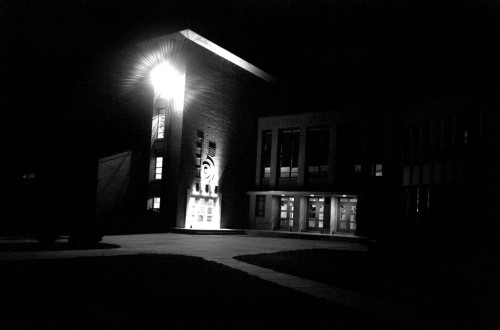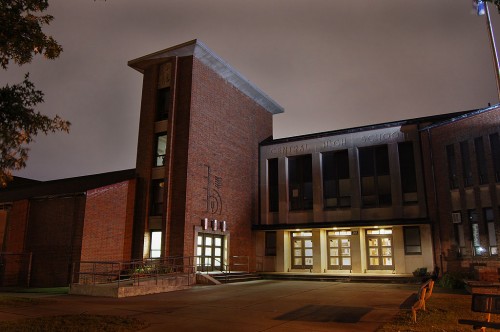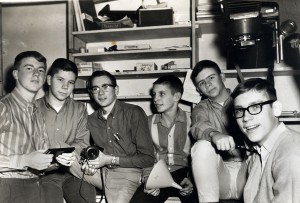Cape Central High School in the mid-60s
I shot the black and white picture of my alma mater, Cape Girardeau Central High School, in 1964 or early 1965 for the 1965 Girardot yearbook. It was taken with a Crown Graphic 4 x 5 camera. That’s all the tech info I have.
Cape Girardeau Central High School October 13, 2009
 This picture was taken Oct. 13, 2009, at 21:39:50 with a Nikon D-40 digital SLR. The zoom lens was at 18mm (27mm in 35mm-speak).
This picture was taken Oct. 13, 2009, at 21:39:50 with a Nikon D-40 digital SLR. The zoom lens was at 18mm (27mm in 35mm-speak).
I underexposed the picture 1-1/3 f/stops, with an exposure of five seconds at f/5. The “film” speed was ISO 200.
I did a little tweaking with Photoshop, but I also remember doing some burning and dodging of the original B&W print.
(Editing film on a lap top is a little hit-and-miss. Everything looks different depending on the angle of the screen, so I don’t know how optimized the image is.)
1965 Girardot Photo Staff
Left to right: Jim Stone, Ronald Dost, head photographer Ken Steinhoff, Skip Stiver, Joe Snell, Gary Fischer. Taken in CHS darkroom c 1964. (NOW do you see why none of of the majorettes dated me?)
The more things change, the more they remain the same
The high school has been converted into a middle school. There are a bunch of new trees in front of the building (and it looks like it’s air conditioned now). The big sign that my senior class voted to put on the front lawn is gone. (I voted against it and thought we should buy books for the library). Another sign has popped up in its place.
Still, it looks remarkably like it did when I walked through the doors as a scared freshman.


Speaking of Photoshop, I’ve been following the Pixilated Image blog lately. (www.pixilatedimage.com). It’s not exactly the style I aspire to, but the guy has given me some new things to think about and try. The information might not be quite so revelatory to a professional photographer like yourself.
Do you shoot in raw mode and use Nikon’s ViewNX software? I’ve just recently started to do that. I never knew why before I started reading Pixilated Image.
BTW, both photos look nice. Where does the light behind the school come from in the recent photo?
Spokesrider, please don’t go down the Nikon NEF/RAW road. It will only lead to misery. Shoot JPEGs and be done with it.
The NEF files off my Nikon D700 are 15mb a piece compared to 5mb for high quality JPEGs. The space necessary to store NEFs is overwhelming.
NEFs also require a more powerful computer with more memory. I have a 1.5gb of memory in my laptop and hate opening NEFs on it because I simply run out of memory. JPEGs, however, open just fine on that same laptop.
NEFs are not good for long-term storage. JPEGs are a universal standard that will be around for hundreds of years. NEFs are a vendor-specific format which third-party support is questionable. (Even Adobe can’t get NEF support right and they are the industry giant.)
Ken Rockwell has a good RAW NEF vs JPEG discussion.
As someone who maintained the electronic photo library for a major-market newspaper, I can assure you our 27 photographers never shot anything other than JPEG. As someone who worked with peers at both Tribune and COX newspapers as well as Associated Press photographers, no one else shot raw either. As an aside, I’ll also add that a ‘normal’ quality JPEG from a D2Hs will look pretty good when blown up to a double-page spread.
Cheers,
Matt
I’m of the bigger is better school of thought, but I still shoot jpegs, although at the highest quality.
When I scan film, I usually scan at 1200 and as TIFF. Prints are usually done at 300 unless it’s something I really want, then I go to 600.
When I edit the scans, I save the edit as a jpg, usually as a Photoshop 7 or 8 quality.
I’ve got pictures of my own going back to 1959 to digitize, plus family pictures going back over 100 years. My goal is not to have to ever go back and do one again.
Spokesrider,
I forgot to answer your question.
The light from the school is coming from whatever lights were behind the school and from a shopping mall nearby.
It was misting rain while I was shooting, so the clouds were hanging low, too.
The lighting is really different between those two shots.
Horace,
What you see is what I got. I used no additional lighting in either picture.
It’s so cool that you have these pictures for comparison.
Thanks, Dottie.
The building has held up very well since it was built in the mid-50s. The principal said, “When the big earthquake comes (Cape is in the New Madrid Earthquake zone), this building is going to be left standing.”
The building was recently wired for Internet connectivity and he said it was a real challenge to go through 18-inch-thick concrete walls.
When I start posting before and after pictures of students who were constructed in that era, I don’t think we’re going to come off as well-preserved as our Alma Mater.
Dottie, for other readers, has one of my favorite must-read-daily blogs that demonstrates that you can commute by bike every day in Chicago (including the winter) and still look chic doing it.
Matt,
Thanks for the links to those articles. One problem, though. They make the point that a better alternative than raw is getting it right the first time, and that raw mode is for those who don’t have the confidence to do that.
But that means raw mode is for me, and deservedly so. In fact, I find it useful for learning what I could have done to get it right the first time.
They also make the point that one can do the same things in Photoshop as you can with ViewNX. I suppose I should shell out the money for Photoshop one of these days. Before getting my Nikon D60 and ViewNX, I had just got along with PhotoFiltre, which can’t do all the things that ViewNX can do.
I had already encountered and considered the disadvantages of a format that may not be around as long as jpegs, and wasn’t planning to rely on it for that.
As for raw format and ViewNX being a resource pig – yes, I’ve noticed. Photoshop is a resource pig, too. (I have it on my computer at work.)
But it is good for me to have learned that good photographers do not universally use or approve of raw format.
I meant to ask another question, too: Are your inline googlemaps now broken like mine are? I hear that Google made some changes to its map displays. I’m wondering if they also broke the working of our inline maps.
I ran into problems getting Google Maps to work when I did the Lake Okeechobee map.
http://www.palmbeachbiketours.com/lake-okeechobee-scenic-trail-lost-map/
I thought it was because it was complex. To make a long story shorter, the only way I can consistently get GM to work these days is to
1. I create the map like usual.
2. I do all of my text and pictures in visual mode (I don’t know enough html to do it directly in html), then I switch to html.
3. I go back to gm and select the Customize and preview embedded map option. I set the size, etc, then copy the embedded html into my page.
4. Save the page.
If you go to the troubleshooting area at
http://avi.alkalay.net/2006/11/google-maps-plugin-for-wordpress.html you’ll see some of this discussed:
You should not have problems with & chars being modified by the WordPress editor. If so, it means you are working with complex maps. Yes, WordPress WYSIWYG editor sucks a little bit. So if you are working with complex maps, you should switch to the plain text editor. You can’t just open the post editor in WYSIWYG and select the plain text editor after that. The mess was already done. You will have to edit your profile under Users->Your Profile and deselect the “Use the visual editor when writing” options when you edit that post. Once it is saved you can reselect it again.
I haven’t done as many maps with lines as you have – and I think they may have all been done after I switched to the method above, so I don’t know if they are hosed up.
I DID go back to look at some of my old maps. Some of them have lost their pinpoint markers, some haven’t. I sure hope Google doesn’t start breaking stuff.
Interestingly enough, some of my IE users have complained that they couldn’t see the pinpoints in the past. They would work fine in Firefox (which I use) and Chrome.
Let me know what you find out. I was just getting accustomed to embedding maps where appropriate. I’d hate to have to quit and / or update old content.